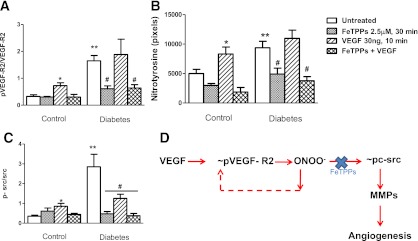FIG. 8.
The differential effect of exogenous VEGF on VEGF signaling in control and diabetic cells. Cells were treated with vehicle, peroxynitrite decomposition catalyst FeTPPs alone, VEGF alone, or VEGF plus FeTPPs. Phosphorylated VEGF receptor activation (p-VEGF-R2–to–VEGF-R2 ratio), peroxynitrite formation, and phosphorylated c-src activation (p-c-src–to–c-src ratio) were determined by immunoblotting, as shown in A–C, respectively. Exogenous VEGF treatment stimulated VEGF-R2 activation, c-src activation, and tyrosine nitration in control cells, and cotreatment with FeTPPs prevented this activation. Diabetic cells that show increased basal VEGF-R2, c-src, and nitrotyrosine activation do not show further elevation in response to exogenous VEGF but respond to FeTPPs treatment, indicating that peroxynitrite sustains VEGF-R2 phosphorylation and also mediates downstream signaling in these cells. D: Schematic representation of the role peroxynitrite in modulation of the angiogenic signal in brain microvascular endothelial cells. *P < 0.05 vs. other control groups; **P < 0.01 vs. untreated control; #P < 0.05 vs. untreated diabetes. (A high-quality color representation of this figure is available in the online issue.)

